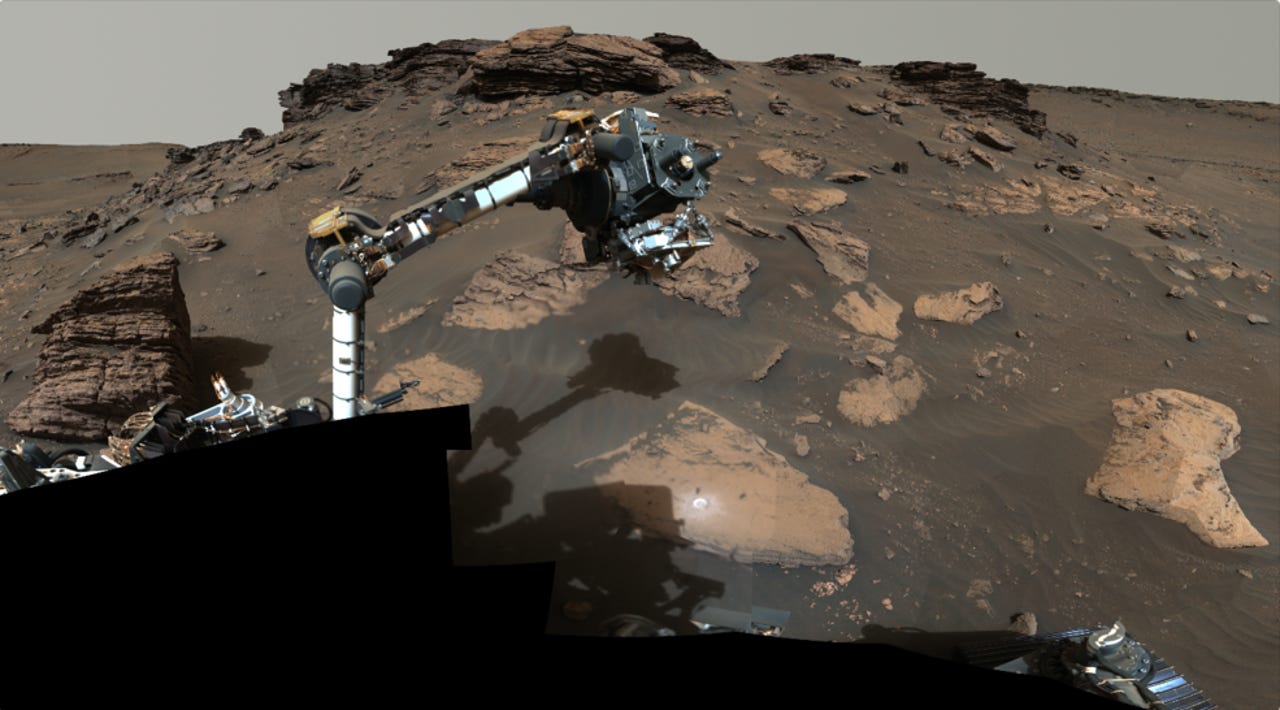NASA's Perseverance rover continues its hunt for ancient life on Mars


NASA's Perseverance rover puts its robotic arm to work around a rocky outcrop called "Skinner Ridge" in Mars' Jezero Crater.
NASA's Perseverance Mars rover has dug up new rock samples at the bottom of a Martian river as part of the quest to find evidence of signs of past life.
Perseverance is amid its second Martian rock collecting campaign and has now collected four more sedimentary rock samples from a once-flowing river delta in the Jezero Crater, bringing its collection to a total of 12 samples since it started on July 7.
Innovation
NASA picked the river delta because it offered the highest odds of finding signs of ancient microbial life. By ancient — if NASA does ever find evidence — that microbial life would have existed about 3.5 billion years ago, when the riverbed was formed.
SEE: What is Artemis? Everything you need to know about NASA's new moon mission
Perseverance is plucking sedimentary rock from a portion where the Martian river and a lake meet in the Jezero Crater. The crater itself is 28 miles (45 kilometers) wide.
Thomas Zurbuchen, NASA's associate administrator for science in Washington, said Perseverance had collected an "amazing diversity" of samples that will be shot back to Earth in the Mars Sample Return campaign in the next decade.
"We picked the Jezero Crater for Perseverance to explore because we thought it had the best chance of providing scientifically excellent samples – and now we know we sent the rover to the right location," said Zurbuchen in a press release.
For the return campaign, NASA plans to launch the Sample Retrieval Lander to Mars in 2028 and land in the Jezero Crater. The lander will carry a NASA-led Mars rocket and a pair of small Mars helicopters. Only when it returns the samples to Earth will NASA scientists know for sure what they consist of.
But if SpaceX chief Elon Musk is right, humans could be in Mars before the rock samples return to Earth. Musk's latest bet is that the earliest date for humans to be on Mars is 2029.
Perseverance and its sibling Ingenuity landed on Mars on February 18, 2021, about seven months after launching from Cape Canaveral, Florida.
Perseverance's first campaign explored Jezero's floor and collected igneous rock, which contain crystals that can tell exactly when they were formed. Rather than sedimentary rocks being collected now, igneous rocks form in molten lava or during volcanic activity.
The rover sports a SuperCam featuring a rock-vaporizing laser, which zapped the rocks during the first campaign to determine it was igneous rock covering the crater's floor.
The two different types of rocks give NASA the ability to understand the crater's geologic past.
"The delta, with its diverse sedimentary rocks, contrasts beautifully with the igneous rocks – formed from crystallization of magma – discovered on the crater floor," said Perseverance project scientist Ken Farley of Caltech in Pasadena, California.
"This juxtaposition provides us with a rich understanding of the geologic history after the crater formed and a diverse sample suite. For example, we found a sandstone that carries grains and rock fragments created far from Jezero Crater – and a mudstone that includes intriguing organic compounds."
SEE: NASA is sending a spacecraft to smash into an asteroid
The new found evidence of organic molecules on Mars is more promising than the Curiosity rover's 2013 finding of evidence of organic matter, according to NASA.
What makes Perseverance's discoveries intriguing is that the organic molecules it has found are in an "area where, in the distant past, sediment and salts were deposited into a lake under conditions in which life could potentially have existed." These were found in a section of the crater called Wildcat Ridge.
"In the distant past, the sand, mud, and salts that now make up the Wildcat Ridge sample were deposited under conditions where life could potentially have thrived"The fact the organic matter was found in such a sedimentary rock – known for preserving fossils of ancient life here on Earth – is important. However, as capable as our instruments aboard Perseverance are, further conclusions regarding what is contained in the Wildcat Ridge sample will have to wait until it's returned to Earth for in-depth study as part of the agency's Mars Sample Return campaign," said Farley.